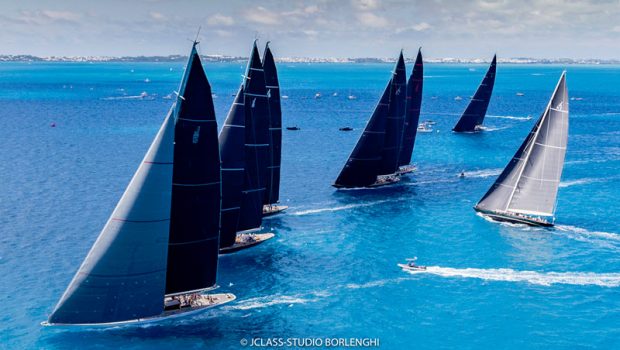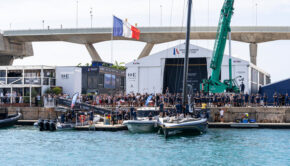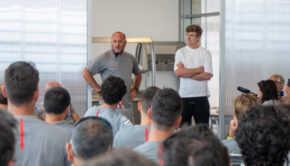Return of the J Class Yacht
Published on June 26th, 2017
J Class yachts, which reigned supreme in the 1930s, are making a thrilling comeback, with restorations, new builds and the biggest fleet the class had ever seen at the America’s Cup J Class Regatta. Why wasn’t the event broadcast, people asked. One theory was the fear of higher viewership than the actual America’s Cup.
In this report by Matthew Sheahan, he charts a return to glory for the class.
Only 10 were ever built from just 20 designs and their reign lasted less than a decade. In their day, J Class yachts were the most technically advanced and universally admired yachts in the world. They drew royalty and captains of industry aboard, while regularly pulling big crowds of spectators to vantage points ashore. But the death of a sovereign, who regularly raced one, and the threat of a world war saw them disappear as fast as they had arrived.
Of the 10 that were raced between 1930 and 1937, six were built in America and four in the UK. Three of the British boats survived, but only just, while all the American ones were scrapped.
Conceived in 1930 as a more affordable alternative to the previous generation of expensive, one-off America’s Cup yachts, now, more than 85 years later, J Class is about to hit a new high. In 2017, seven J Class owners raced their boats in Bermuda – the biggest fleet the class had ever seen (see photos).
Of the original examples that still existed, Endeavour was the first to be fully restored back in the 1980s. Velsheda and Shamrock V followed. Since then, all three have been newsworthy sights at some of the most famous yachting venues around the world. From there, fascination with the Js continued, but with no original boats to restore, people started building replicas.
The first was the American yacht Ranger. “When we launched her in 2003 she was the first new-build J Class yacht for 66 years,” says owner John Williams. “I have had a number of large yachts over the years, but owning a J Class is like owning an F1 car, you simply can’t go back.”
The launch of Ranger, combined with Williams’ success on the water, inspired the construction of others, including Hanuman, the modern interpretation of aviation pioneer and yachtsman Thomas Sopwith’s 1936 J Class, Endeavour II.
Indeed, it was the competition between Endeavour II and the original Ranger that rekindled interest in the last J Class battle for the America’s Cup in 1937, when Harold Vanderbilt wiped the floor with Endeavour II in a match that brought down the curtain on prewar J Class activity and the class itself.
Some owners are now even building yachts from original 1930s lines plans that were never actually constructed. Lionheart was the first– one of seven rejected Ranger models from 1936. Svea, which launched earlier in 2017 (see photos), is the latest example – based on an original Tore Holm design from 1937, brings the total in the J Class fleet to nine.
Over three decades, J Class fever has taken a hold at a price tag of around $16.5m apiece. They are expensive boats to run too, costing around $1.3m to $2.5m per year for a racing J. The most competitive might even have new sails for each regatta, so with a single genoa priced at around $127,000, campaigning these boats is not for those looking to compete on a modest budget. And herein lies part of the appeal.
A J Class is not simply a type of yacht – it’s a phenomenon and has always attracted the world’s wealthiest individuals. In addition to Sopwith, Vanderbilt, George V and tea magnate Thomas Lipton were among the famous owners on both sides of the Atlantic. As well as satisfying a personal zest for yacht racing, the boats drew attention that often helped develop their global businesses.
Today, many current owners are equally accomplished, whether as captains of industry, technology or the internet, but in contrast to their forebears many prefer anonymity and are discreet about their professional backgrounds. That said, they are just as besotted with what are described as the most beautiful yachts in the world. Such is the legacy of the J that many see their ownership as simply custodial, even if the boats are replicas.
Back in 1984, American writer and businesswoman Elizabeth Meyer kick started the reincarnation of the J Class when she bought the derelict and barely floating hulk of Endeavour. One of the most famous of all the Js, Endeavour is still widely considered to have been Britain’s best chance of winning the America’s Cup in over 160 years. A full restoration programme saw the yacht back afloat in 1989.
“The size and beauty of these boats is a huge draw. It is hard to make a boat look as beautiful as a J does – there is some magic to it,” says Dutch businessman Ronald de Waal. As the owner of Velsheda, he admits to being hooked on the class. “Their history is also an attraction. They all have a big provenance.”
De Waal’s involvement started almost by accident but quickly led to Velsheda’s full restoration from a bare hull and deck. “I had bought a 40m yacht that caught fire during trials, which led to me looking for another boat,” he explains. “Yacht designer Gerard Dykstra found out there was a J Class hull that had been confiscated after the boatyard restoring it ran into financial difficulties. I paid off the shipyard and the bank, bought the hull and set about restoring the boat, and in 1997, she was launched.”
De Waal is the longest-serving J Class owner and remains very active on the racing scene. His enthusiasm and support, along with Dykstra’s design expertise, have been instrumental in the development of the current fleet. Where Meyer was the catalyst, De Waal and Dykstra have created solid foundations for the class. “To own a boat like Velsheda is to own something that is irreplaceable,” says De Waal. “It’s not just about the money, it’s the history and the almost spiritual feeling about the boat and what she stands for. It reminds me of life and living, it’s that strong a connection.”
Dykstra and his design team have been involved in no fewer than six different Js, with another on the drawing board, and remain closely involved with the practical day-to-day aspects of running a J campaign. “When you step aboard a J, you are not just a sailor but a part of yachting history,” says Dykstra. “The sailing is impressive, but it’s impossible not to be affected by the sense of heritage and the part these boats have played. They drew huge crowds in their day, and today’s spectators are equally fascinated.”
While the J Class continues to epitomise all that was grand, elegant and competitive about yacht racing in the 1930s, the reality is that these boats were, and remain, challenging brutes to handle. Not surprisingly, their immense power and complexity attract some of the world’s top professional sailors.
Jeroen de Vos at the Dykstra design office is one of several staff who sail regularly on Js. “Of the 30 or so crew aboard, more than 20 need to be highly experienced sailors,” he says. “You have to work flawlessly as a team because the boats are so powerful that the slightest mistake can result in a serious situation. The level of competition is also extremely high.”
Following the racing in Bermuda, the aim of the fleet is now the 2017 J Class World Championship on August 21-26 in Newport, RI
Sharing the credit for the new wave of Js is designer Andre Hoek who has created five of the modern Js. His work has concentrated on yachts like Lionheart and Topaz, modern builds from original lines.
“The move to aluminum as a construction material has been a big step for the class and one of the key factors in their current appeal,” he says. “Originally the boats were stripped-out racing machines built from steel. Today, owners want full interiors with creature comforts and systems that allow them to cruise the boats as well. A lighter aluminium build means they can have these interiors and still float to their original lines.”
Another key factor has been the clever handicapping system that ensures equitable racing at all the events. The handicap system was originally developed by Dykstra in conjunction with technical experts at the Wolfson Unit at Southampton University, which required detailed performance analysis. Andre Hoek’s team has also spent time assessing the current and future performances of the Js, but for subtly different reasons.
“We conducted a huge amount of research with velocity prediction programs to assess the various performances of the boats, both those that had been built and those that were just designs,” says Hoek. “The result is we now know more about why certain hulls work and others don’t. We can also see which of the original designers were working along the right lines.”
The willingness and enthusiasm of owners to take their elegant yachts to the mid-Atlantic island of Bermuda in June 2017 is testament to both the continued pull of the America’s Cup and to the historical significance of the J Class.
“It’s rare for a venue to host more than a few boats, but the Hamilton Princess hotel in the centre of the town provided berthing for all the Js,” says J Class Association secretary and event organiser Louise Morton. “This created an incredible spectacle, right at the heart of the event.”
J Class yachts could not be more different from the modern, lightweight, high-speed, hydrofoiling catamarans that are the current America’s Cup boats.
A J Class has a single 41m hull, a lead keel and over 900sq m of sail. She requires around 30 crew, weighs around 150 tonnes and has a typical maximum speed of 12 knots (14mph). A modern America’s Cup catamaran is 15m long, has two hulls, flies above the water on hydrofoils at speeds approaching 52 knots (60mph) and is powered by an aeroplane-style wing sail. The boat is sailed by just six crew and weighs only 1,320kg.
On the face of it there is no comparison, yet they share the same DNA. Just as current foiling catamarans are defining new limits, the Js of the 1930s represented the leading edge of yacht design and construction, their size and loads pushing at the limits of what was technically possible.
But it wasn’t just the boats and their towering 50m masts and colossal sails that were breaking new ground; systems and technologies developed elsewhere on the boat were also helping to shape the modern era of both racing and cruising yachts. A good example is the development of electronic sailing instrumentation for information on wind strength and direction. First used on Sopwith’s J Class Endeavour II, such instrumentation soon became commonplace.
Even to this day, such technical developments have continued. “In the early 1990s, the winches on these boats were manually powered by the crews winding pedestal grinders,” explains Dykstra. “Now those grinders have been replaced with hydraulically powered winches that allow crews to handle the boats more efficiently. It has changed the game and led to more advanced systems and new sailing techniques.”
So while the enthusiasm for this classic yacht may appear to be driven by nostalgia, the boats are continuing to do exactly what they were originally designed to do – push the boundaries and create the ultimate racing machine. Sometimes history repeats itself in unexpected ways.









 We’ll keep your information safe.
We’ll keep your information safe.